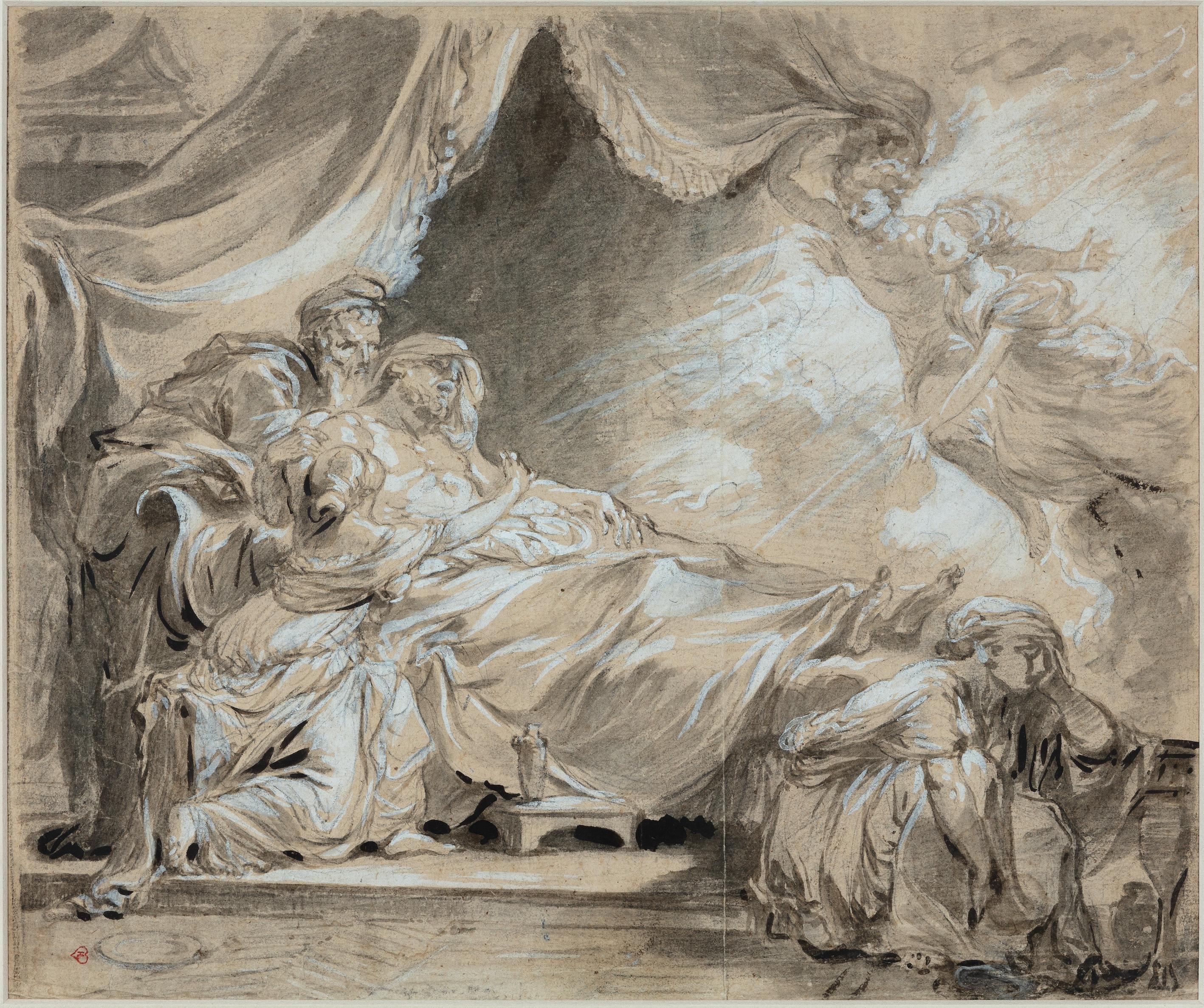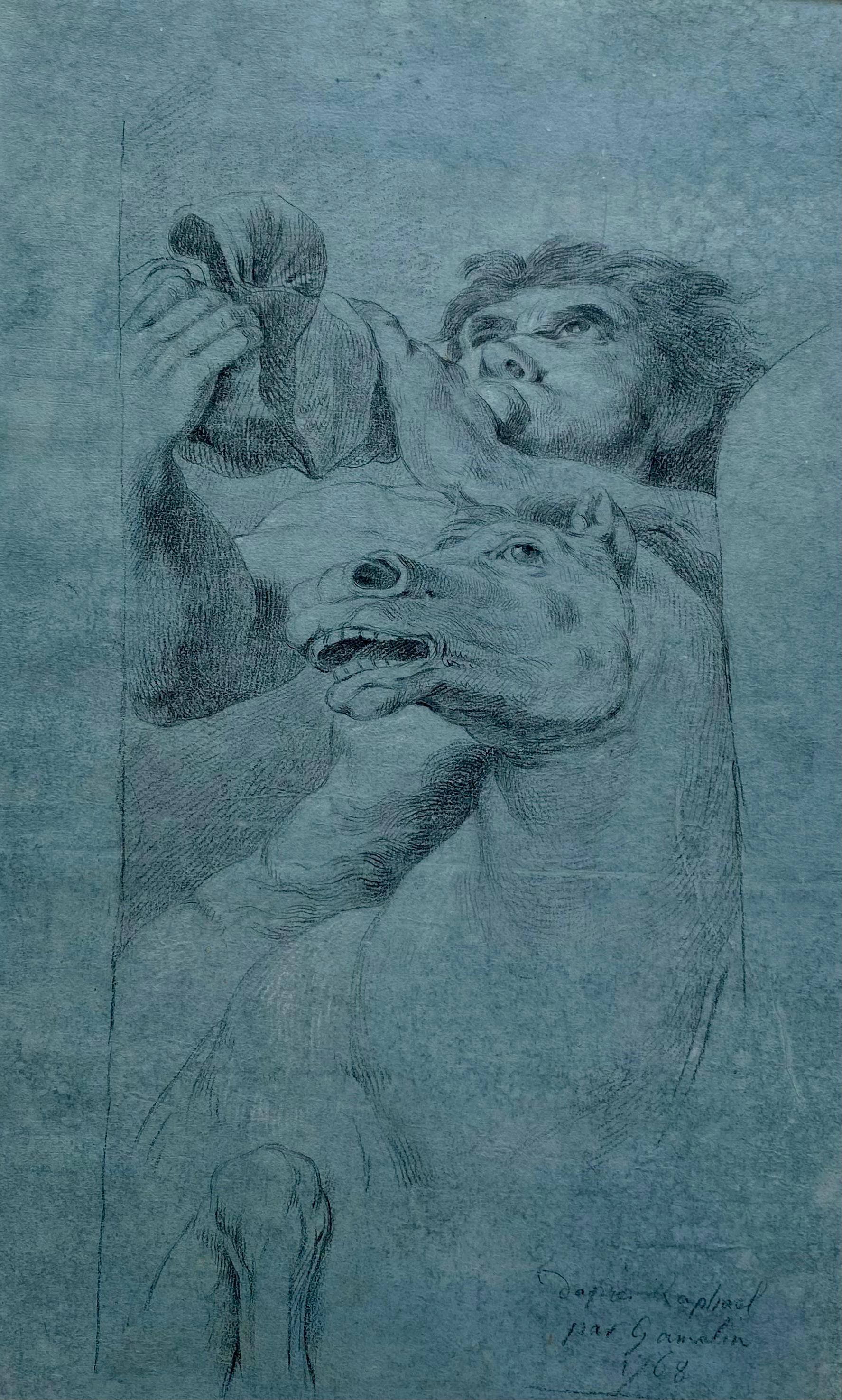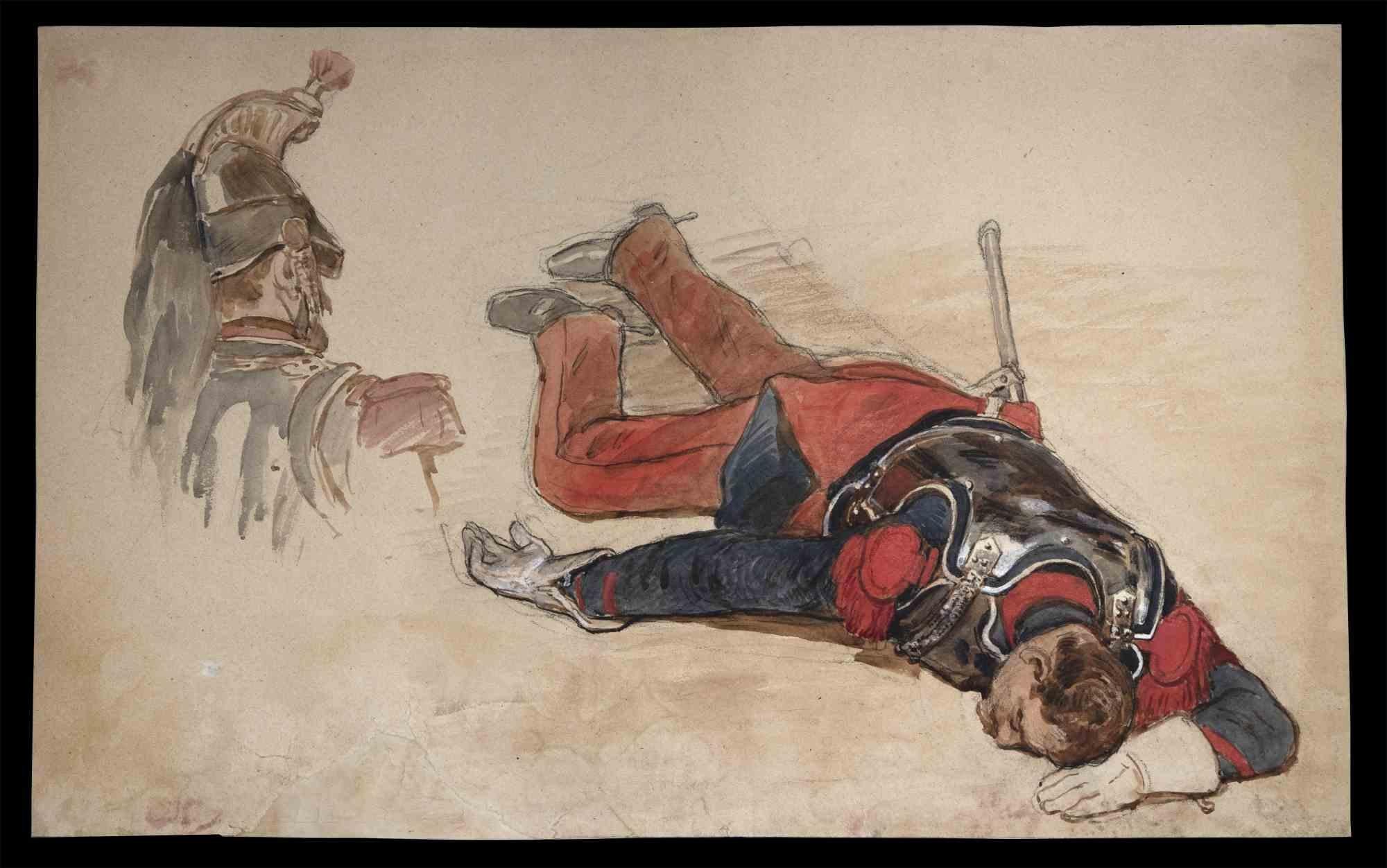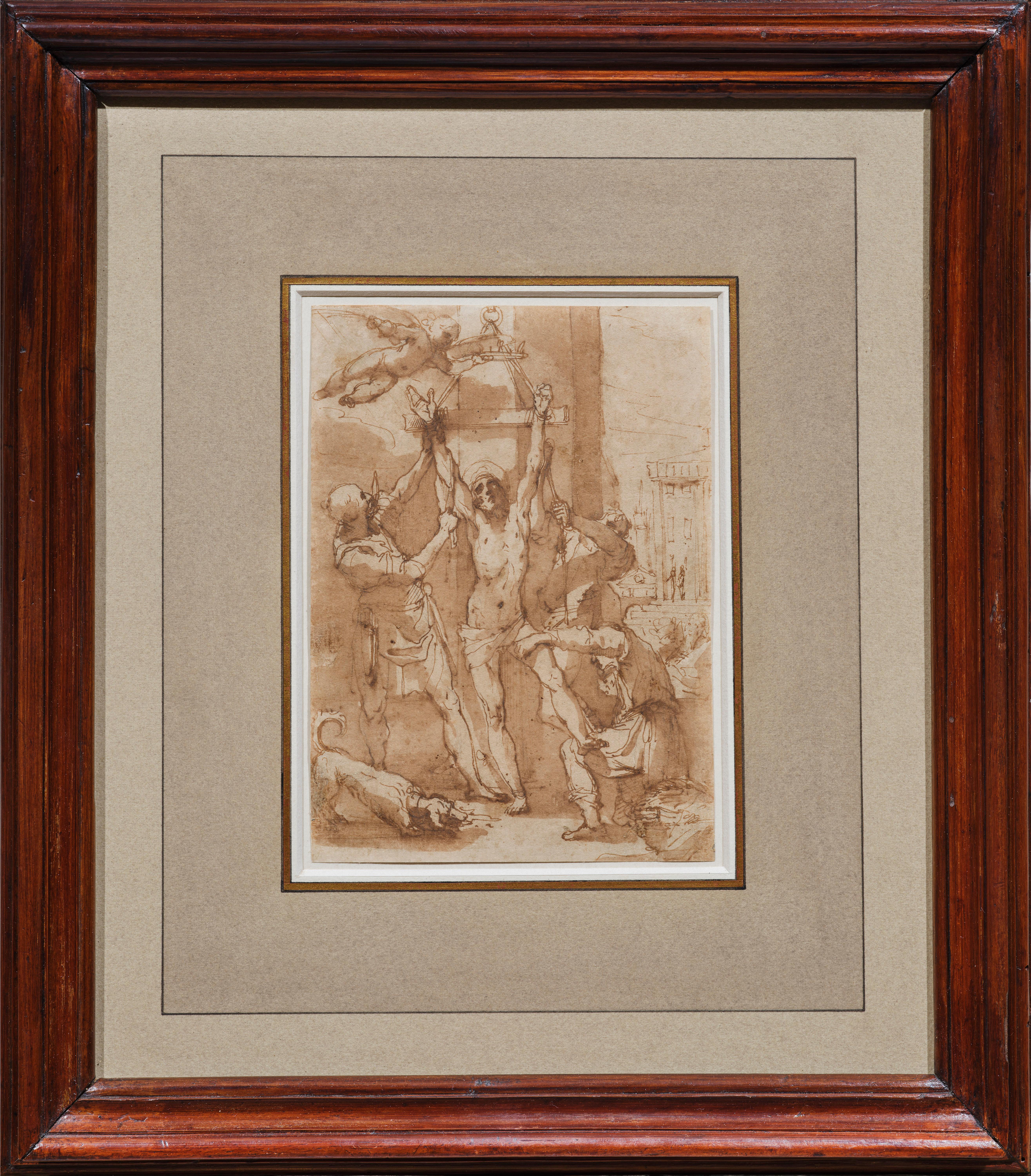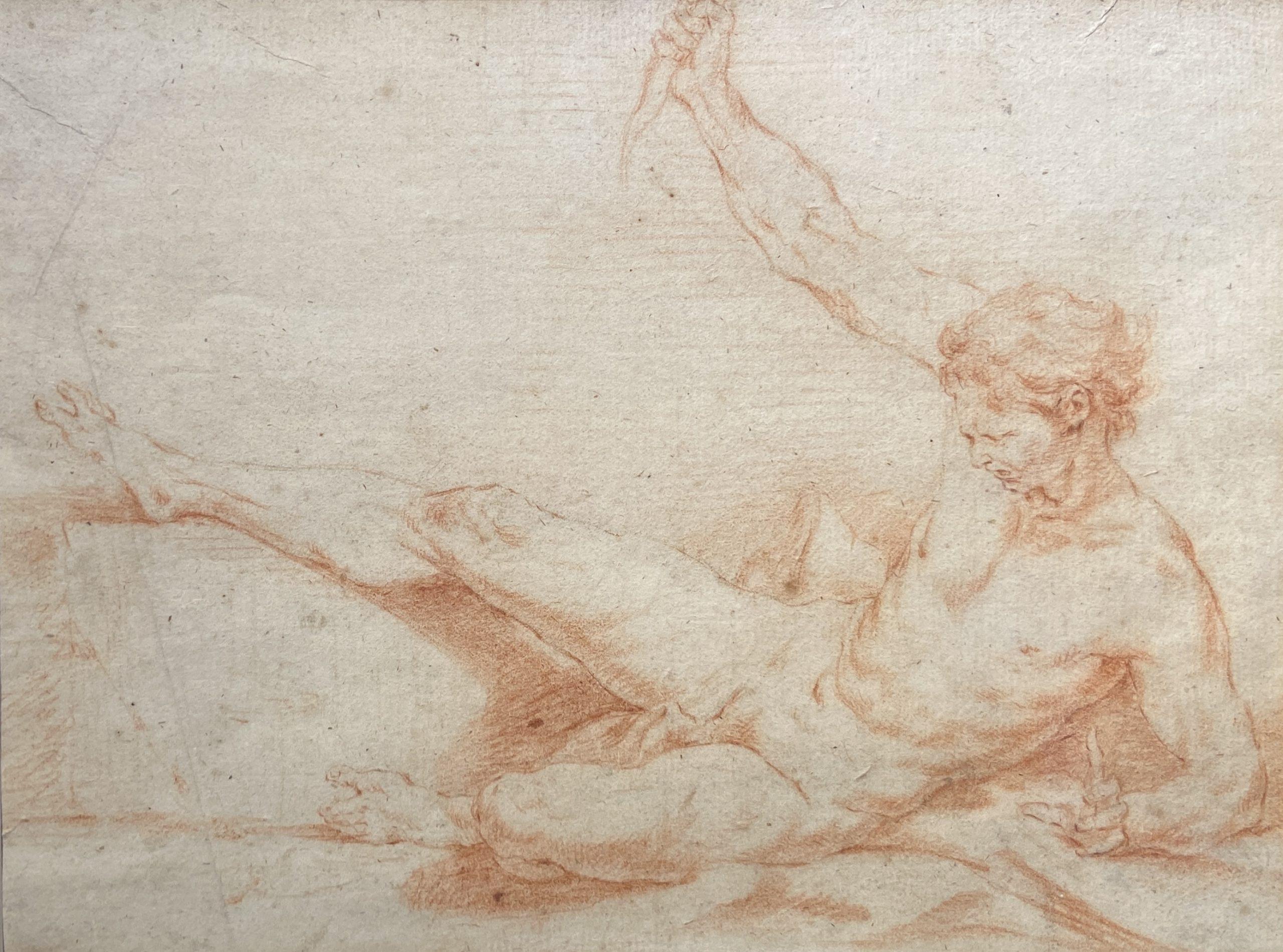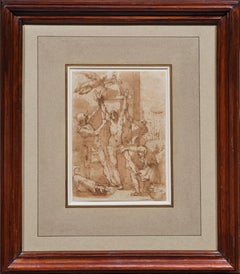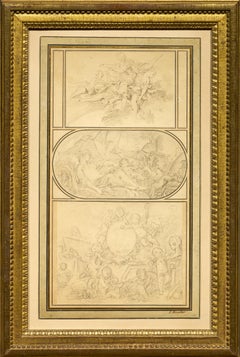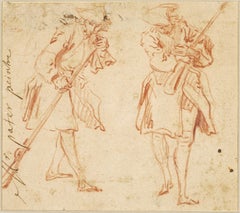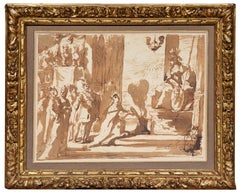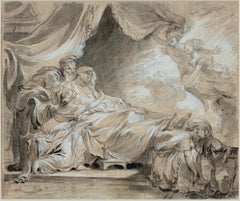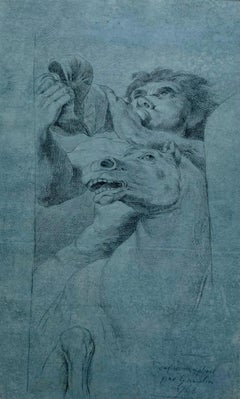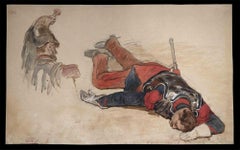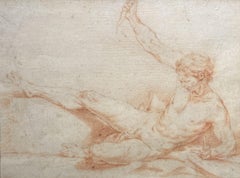Items Similar to Soldier begging for Mercy a preparatory study by Jean-Marc Nattier (1685 - 1766)
Want more images or videos?
Request additional images or videos from the seller
1 of 10
Jean-Marc NattierSoldier begging for Mercy a preparatory study by Jean-Marc Nattier (1685 - 1766)1717
1717
$16,462.89
£12,169.66
€13,800
CA$22,834.88
A$24,895.02
CHF 13,154.05
MX$306,150.11
NOK 163,559.96
SEK 153,970.04
DKK 105,079.90
About the Item
This rare drawing by Nattier is part of a set of preparatory studies executed in 1717 for one of the painter's first commissions, the painting commissioned by Tsar Peter I of Russia to celebrate his victory over the Swedes at Poltava in Ukraine on July, 8th 1709. Kept in Nattier's studio (he did not paint any other battle scenes), these studies were later used to decorate the background of military portraits depicting battles.
1. Peter I of Russia, one of Nattier's first patrons
Jean-Marc Nattier was born in Paris in 1685 into a family of artists: his father Marc was also a portraitist and his mother Marie Courtois was a miniaturist, his brother Jean-Baptiste was also a painter.
Gifted with a very precocious talent, he won first prize for drawing at the Academy at the age of fifteen. Although his godfather, the painter Jean Jouvenet (1644 - 1717), gave him the opportunity to go to the French Academy in Rome, he preferred to stay in Paris and made drawings of the paintings by Rubens in the famous Luxembourg Palace gallery commissioned by Marie de Médicis. He was then admitted to the Académie in 1713 and became a full member in 1718.
In 1716, an envoy of the Russian Tsar Peter I convinced him to go to Amsterdam, while the Tsar was visiting, and then follow him to Russia. When in Holland, he painted a portrait of Peter I’s wife, the future Empress Catherine II, and a painting representing the Battle of Poltava. Nattier preferred to return to Paris than to follow the Tsar to Russia, but he did paint his portrait between May and June 1717 during the latter's visit to Paris.
Nattier then became the portraitist of the Orleans family and, from 1748 onwards, of the Court of Louis XV. He died in 1766 ill and destitute, shunned by the public after having enjoyed extraordinary success as a portraitist during his mature years.
2. The Victory of Poltava, a major painting with a rich body of preparatory studies
Peter I, better known as Peter the Great, was born on 30 May 1672 in Moscow and died on 28 January 1725 in St Petersburg. He became Tsar of Russia in 1682 and received the title of Emperor of all the Russias in 1721, at the conclusion of the Great Northern War (1700-1721) opposing Russia to the Swedish Empire of Charles XII, of which the victory of Poltava (now in Ukraine) in 1709 was a decisive turning point.
Nattier's composition (4th photo in the Gallery) during his stay in Amsterdam in 1717 presents an imaginary view of this battle in which the painter does not attempt to render the specificity of the place, but rather translates the confusion of the battle between the Russian army (in green uniforms) and the Swedish army (in blue uniforms).
Nattier took particular care in the preparation of this work, drawing a study for each of the soldiers involved in the battle. The drawing we are presenting is one of five known studies , the other four represent:
• a study of an officer wearing a tricorn (a preparatory sketch for the figure of the Tsar - last photo of the gallery);
• a study of a rider (for the rider on the left of the Tsar);
• a study for the soldier wielding the bayonet rifle in the centre of the painting,
• a study for the Russian soldier lying under the white horse in the centre of the painting.
Although our drawing is unusual in that it was not used in the final composition, its execution by Nattier was recognised by Xavier Salmon , the author of the catalogue of the Versailles exhibition (where the Calvet Museum drawing was displayed).
While the Victory of Poltava is the only battle scene the painter painted, these studies constituted a portfolio which the painter used throughout his career to decorate the background of his military portraits.
3. Description of the artwork
This drawing represents a soldier on the ground, leaning on his left elbow and raising his right arm, begging for mercy. It is vigorously executed and organised around two diagonals that cross at the level of the soldier's chest: that of his arms, extended by his open hands as a sign of abandonment and despair, and that of the reverse of our soldier's jacket, extended by the arch of his nose.
While the shadow cast on the ground by the soldier adds a dramatic dimension to the scene, the few strokes of white chalk enliven the drawing and poignantly underline the character's immense vulnerability: the hands, the uncovered face with its imploring mouth, the belt that seems to have broken in his fall.
We have chosen to frame this drawing with Bérain rods dating from the first quarter of the 18th century, which were supplied to us by the Maison Lebrun.
Main bibliographical references :
Le dessin français au XVIIIe siècle Louis-Antoine Prat Edition Musée du Louvre/ Somogy éditions d'art March 2017
Jean-Marc Nattier Xavier Salmon - Réunion des Musées Nationaux, Paris 1999
- Creator:Jean-Marc Nattier (1685 - 1766, French)
- Creation Year:1717
- Dimensions:Height: 15 in (38.1 cm)Width: 13.38 in (33.99 cm)
- Medium:
- Movement & Style:
- Period:1710-1719
- Condition:9 7/16” x 7 7/8” (24 x 20 cm) - Framed 15” x 13 3/8” (38 x 34 cm) Provenance: this drawing remained in Nattier's studio until his death. It was then acquired by the Parrocel family and sold by their descendants in 1983.
- Gallery Location:PARIS, FR
- Reference Number:1stDibs: LU1568213229972
About the Seller
5.0
Vetted Professional Seller
Every seller passes strict standards for authenticity and reliability
Established in 2020
1stDibs seller since 2021
10 sales on 1stDibs
Typical response time: 3 hours
- ShippingRetrieving quote...Shipping from: PARIS, France
- Return Policy
Authenticity Guarantee
In the unlikely event there’s an issue with an item’s authenticity, contact us within 1 year for a full refund. DetailsMoney-Back Guarantee
If your item is not as described, is damaged in transit, or does not arrive, contact us within 7 days for a full refund. Details24-Hour Cancellation
You have a 24-hour grace period in which to reconsider your purchase, with no questions asked.Vetted Professional Sellers
Our world-class sellers must adhere to strict standards for service and quality, maintaining the integrity of our listings.Price-Match Guarantee
If you find that a seller listed the same item for a lower price elsewhere, we’ll match it.Trusted Global Delivery
Our best-in-class carrier network provides specialized shipping options worldwide, including custom delivery.More From This Seller
View AllThe Martyrdom of Saint Bartholomew, a preparatory drawing by Alessandro Casolani
Located in PARIS, FR
This powerful pen and brown ink wash drawing is a study for an altarpiece depicting The Martyrdom of Saint Bartholomew. Signed and dated 1604, it was painted at the end of his life b...
Category
Early 1600s Old Masters Figurative Drawings and Watercolors
Materials
Ink, Pen
Three drawings by François Boucher in a mounting by Jean-Baptiste Glomy
By François Boucher
Located in PARIS, FR
We would like to thank Juliette Parmentier-Courreau of the Custodia Foundation for her welcome and support during the consultation of Glomy’s Journal des Ouvrages.
This spectacularly large "feuille de desseins ajustés" commissioned by François Boucher from Jean-Baptiste Glomy is emblematic of the painter's art and mastery of rocaille. It is also fully representative of the taste of this period in the field of decorative arts. The largest of these three drawings, placed at the bottom of the composition, is particularly interesting: dating from around 1756, it constitutes a modello (apparently unpublished) for the frontispiece of the "Catalogue des tableaux de Monsieur de Julienne"), preserved in the Morgan Library in New York.
1. François Boucher, the master of French rocaille
The extraordinary career of Francois Boucher was unmatched by his contemporaries in versatility, consistency and output. For many, particularly the writers and collectors who led the revival of interest in the French rococo during the last century, his sensuous beauties and plump cupids represent the French eighteenth century at its most typical. His facility with the brush, even when betraying the occasional superficiality of his art, enabled him to master every aspect of painting – history and mythology, portraiture, landscape, ordinary life and, as part of larger compositions, even still life. He had been trained as an engraver, and the skills of a draftsman, which he imbued in the studio of Jean-Francois Cars (1661 – 1738), stood him in good stead throughout his career; his delightful drawings are one of the most sought-after aspects of his oeuvre.
As a student of Francois Lemoyne (1688 - 1737), he mastered the art of composition. The four years he spent in Italy, from 1727-1731, educated him in the works of the masters, classics and history, that his modest upbringing had denied him.
On his return to Paris in 1734, he gained full membership of the Royal Academy of Painting and Sculpture with his splendid Rinaldo and Armida (Paris, Musée du Louvre). Although, throughout his career, he occasionally painted subjects taken from the Bible, and would always have considered himself first as a history painter, his own repertoire of heroines, seductresses, flirtatious peasant girls and erotic beauties was better suited to a lighter, more decorative subject matter. His mastery of technique and composition enabled him to move from large scale tapestry...
Category
1750s Old Masters Figurative Drawings and Watercolors
Materials
Chalk, Ink
Two military studies, a preparatory red chalk drawing by Jean-Baptiste Pater
By Jean-Baptiste Pater
Located in PARIS, FR
As Florence Ingersoll-Smouse wrote in 1921 in her book devoted to Jean-Baptiste Pater, "a painter of the Fête galante, Pater is interesting both by his intimacy with Watteau, to whom many of his works are still attributed, and by his own value as an artist.” This sanguine, full of life and spontaneity, is typical of the preparatory studies made by the painter to be used later in the composition of his paintings.
1. Jean-Baptiste Pater, pupil and disciple of Antoine Watteau
Antoine Pater, Jean-Baptiste's father, belonged to the petty bourgeoisie of Valenciennes where he worked as a merchant-sculptor. His brother Jacques was a local painter who was probably involved in his nephew's training. Born on December 29, 1695, Jean-Baptiste Pater was first trained with Jean-Baptiste Guider, a local painter whose death in 1711 was probably the reason for Jean-Baptiste’s departure alongside Watteau, who was visiting Valenciennes. Watteau's difficult character led to their separation in 1713.
Back in Valenciennes, Jean-Baptiste Pater encountered difficulties with the powerful Corporation of Saint-Luke (to which he refused to belong) which forced him to return to Paris in 1718. He reconciled with Watteau shortly before his death (on July 18th 1721), inherited the commissions that Watteau had been unable to fulfil and completed some of his paintings.
Pater was accepted by the Académie Royale in 1725 but did not produce his reception painting The soldier’s revels until three years later. Throughout his brief career (he died at the age of forty on July 25th 1736), he mainly had a clientele of amateurs and received only one royal commission, shortly before his death.
2. Description of the drawing and related artworks
Pater had adopted his master Watteau's method of composition. His study drawings were carefully glued in a notebook and were used to animate his compositions.
His paintings sometimes suffer from a somewhat artificial composition, since the figures seem to be pasted one next to the other. This point has also been made about Watteau’s.
The theme of military scenes (which was at the time included in the genre of Fêtes galantes!) was one of Pater’s favourite subjects. Together with the Bathing Women...
Category
1720s Old Masters Figurative Prints
Materials
Chalk
Allegory of the Treaty of Angoulême, a drawing attributed to Donato Mascagni
Located in PARIS, FR
We would like to thank Mrs. Ursula Verena Fischer Pace for suggesting the attribution to Donato Arsenio Mascagni.
We were immediately seduced by the rich tonalities of this allegory...
Category
1620s Old Masters Figurative Drawings and Watercolors
Materials
Ink
Three studies executed in the Pitti Palace in 1761 by Jean-Honoré Fragonard
By Jean-Honoré Fragonard
Located in PARIS, FR
This brilliant study sheet, of which we present here a counterproof, is a souvenir of Fragonard's return journey from Italy. Between April and September 1761, he accompanied the abbot of Saint-Non on his way back to France. Three studies after the masters taken from the Pitti Palace’s gallery in Florence are gathered on this sheet. Although The Ecstasy of Saint Margaret...
Category
1760s Old Masters Figurative Drawings and Watercolors
Materials
Carbon Pencil
Study for a Hunting Scene, a red chalk sketch attributed to Karel du Jardin
Located in PARIS, FR
We would like to thank Carolina Trupiano Kowalczyk for suggesting this attribution to Karel du Jardin after direct examination of the artwork. Her study of the drawing (in Italian), ...
Category
1650s Old Masters Figurative Drawings and Watercolors
Materials
Chalk, Ink, Laid Paper
You May Also Like
The Death of Coresus
By Jean-Baptiste Greuze
Located in Paris, Île-de-France
JEAN-BAPTISTE GREUZE
(Tournus 1725 - 1805 Paris)
The Death of Coresus, circa 1750
Pen and brown ink, black ink tips, gray wash on black chalk, 455 x 385 cm
Bears on the reverse in ...
Category
18th Century Old Masters Figurative Drawings and Watercolors
Materials
Ink, Watercolor
Jacques Gamelin (1738-1803) Study After Raphaël, 1768, Black Stone White Chalk
Located in PARIS, FR
Jacques GAMELIN
Carcassone 1738-1803
Study after the triton of the Triumph of Galatea by Raphaël
1768
Black stone and light white chalk on blue paper
Signed and dated lower right
41...
Category
18th Century French School Figurative Drawings and Watercolors
Materials
Chalk, Handmade Paper
Dead Soldier - Original Drawing by Jules Cornillier - 19th Century
By Jules Cornillier
Located in Roma, IT
Dead Soldier is an original drawing in Pastel, ink, and watercolor realized in the 19th Century by Jules Cornillier (1830-1886).
Fair conditions.
The artwork is depicted through st...
Category
19th Century Modern Figurative Drawings and Watercolors
Materials
Ink, Watercolor, Pencil
The Death of Attis, 18th Century French Red Chalk Drawing, Greek Mythology
Located in London, GB
Red chalk on paper
Image size: 9 x 7 inches (23 x 17.75 cm)
Acid free mount
The Greek god Attis was the spouse of Cybele, the fertility goddess. He was from Phrygia, a kingdom in c...
Category
18th Century French School Figurative Drawings and Watercolors
Materials
Chalk
Dead Soldier - Drawing by Jules Cornillier - 19th Century
By Jules Cornillier
Located in Roma, IT
.Dead Soldier is an original drawing in Pastel, ink, and watercolor realized in the 19th Century by Jules Cornillier (1830-1886).
Good condition.
The artwork is depicted through st...
Category
19th Century Modern Figurative Drawings and Watercolors
Materials
Pastel
A Youth at His Devotions /// after Raphael Raffaello Sanzio Renaissance Italian
Located in Saint Augustine, FL
Artist: William Young Ottley (English, 1771-1836)
Title: "A Youth at His Devotions"
Portfolio: The Italian School of Design: Being a Series of Fac-Similes of Original Drawings, By th...
Category
1810s Victorian Figurative Prints
Materials
Etching, Intaglio
More Ways To Browse
Preparatory Drawing
Antique Battle Painting
Figure Sketch
Military Portrait
Louvre Edition
Russian Tsar
Army Uniform
Antique Military Portraits
Jean Marc Nattier
Empress Catherine
Gibson Girl
Head Of Woman Drawing
Simon Sparrow
Antique Lead Pencils
Bernard Becan
Black Fashion Illustration
Frank Girard
Golf Watercolor Art
